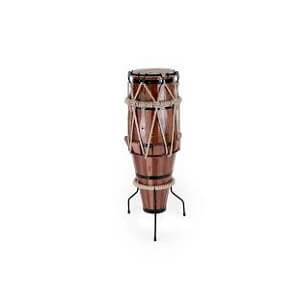Atabaque
 The atabaque is a single-head membranophone from northeastern Brazil where it is associated with a number of Afro-Brazilian sacred and secular traditions. For the Yoruba-derived Candomblé religious practice, three atabaques of like construction but differing in size are used. Candomblé is a collective act of worship where music and dance serve as a means to communicate with the deities. Instruments used in this spiritual practice often have to go through a series of painstaking consecratory rites and women are strictly forbidden from playing them. A single atabaque is used in the African-derived martial arts tradition of capoeira Angola. In this rich tradition the atabaque is one of a small number of drums that along with musical bows (berimbaus) produce the strong and inspiring rhythms for the dancers.
The atabaque is a single-head membranophone from northeastern Brazil where it is associated with a number of Afro-Brazilian sacred and secular traditions. For the Yoruba-derived Candomblé religious practice, three atabaques of like construction but differing in size are used. Candomblé is a collective act of worship where music and dance serve as a means to communicate with the deities. Instruments used in this spiritual practice often have to go through a series of painstaking consecratory rites and women are strictly forbidden from playing them. A single atabaque is used in the African-derived martial arts tradition of capoeira Angola. In this rich tradition the atabaque is one of a small number of drums that along with musical bows (berimbaus) produce the strong and inspiring rhythms for the dancers.
Its shell/body is constructed like a barrel but its shape might best be described as conical with a bulge. The drum shell is comprised of seven wooden staves that are coopered together with five metal bands. The membrane is pelt from a cow with the fur still completely intact. The membrane is lapped around a stiff hoop slightly larger in diameter than the opening in the shell that it covers. Hemp rope zig-zags from the head hoop to a metal tension ring (or counter hoop) near the base of the shell. This ring is sufficiently larger in diameter than the drum shell at that point, allowing for eight wedges (cunha) to be driven between it and the shell (atabaques using this mechanism are referred to as atabaque cunha, or ‘wedge atabaque’). Atabaques can also utilize a tension control mechanism involving several pegs puncturing the shell in a circle just below the head. In lieu of a foot the drum rests on a metal tripod ring-frame.